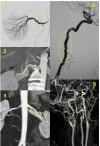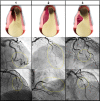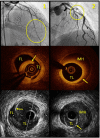Spontaneous coronary artery dissection: contemporary aspects of diagnosis and patient management
- PMID: 30487978
- PMCID: PMC6241978
- DOI: 10.1136/openhrt-2018-000884
Spontaneous coronary artery dissection: contemporary aspects of diagnosis and patient management
Abstract
Spontaneous coronary artery dissection is an increasingly recognised cause of acute coronary syndromes, especially in young and middle-age women. Recognising its particularities and differences with atherosclerotic disease is central for appropriately identifying and approaching these patients. The authors review the current state of knowledge on spontaneous coronary artery dissection and provide practical recommendations for the diagnosis and management of this condition, both in the acute and convalescence phases.
Keywords: coronary angiography; coronary artery disease; interventional cardiology; peripheral vascular disease.
Conflict of interest statement
Competing interests: None declared.
Figures





References
Publication types
LinkOut - more resources
Full Text Sources
